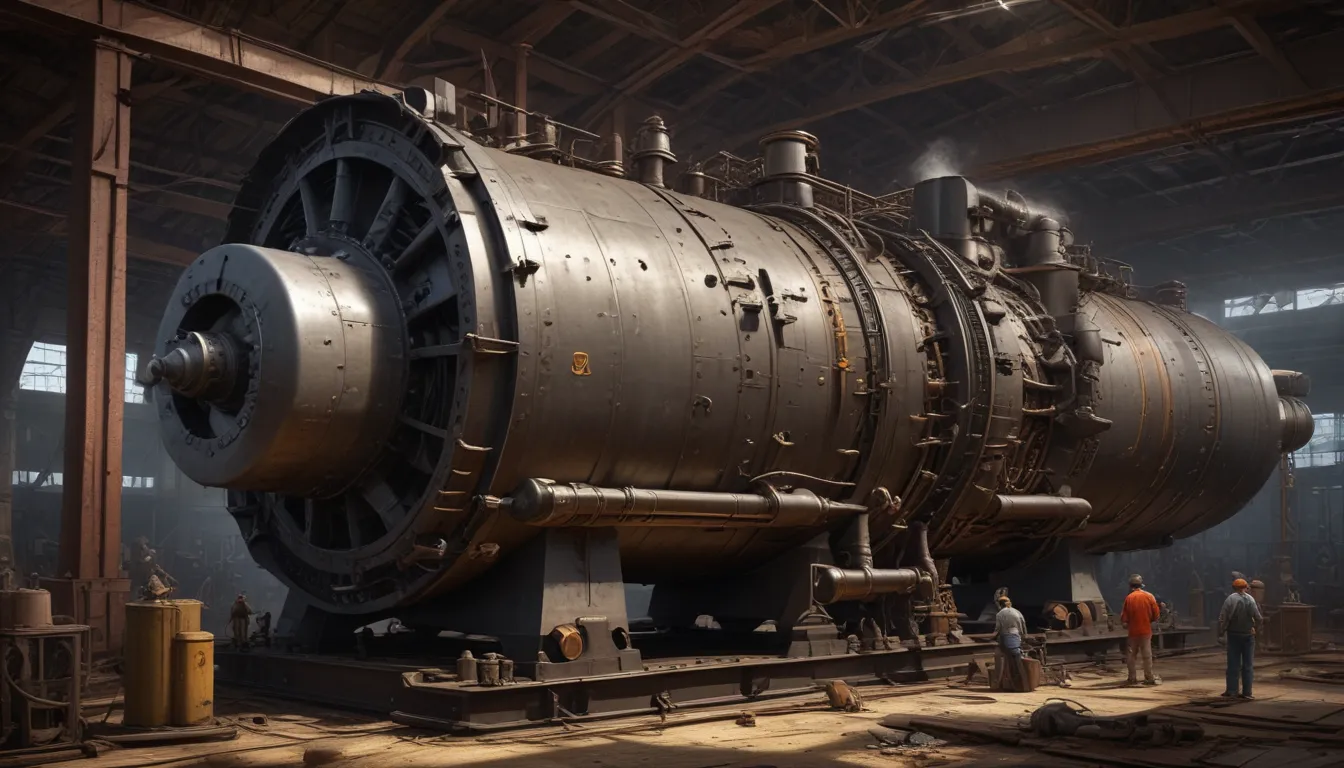A Note About Images: The images used in our articles are for illustration purposes only and may not exactly match the content. They are meant to engage readers, but the text should be relied upon for accurate information.
Are you curious about the transformative impact of the Bessemer Converter on the steel industry? Dive deep into the captivating world of this groundbreaking invention that revolutionized steel production and shaped the modern world we live in today. From its humble origins to its lasting legacy, the Bessemer Converter has left an indelible mark on industries ranging from construction to warfare. Join us as we explore 14 fascinating facts about this extraordinary innovation and uncover the secrets behind its success.
The Bessemer Converter: A Game-Changer for Steel Production
In the 19th century, Sir Henry Bessemer invented a device that would change the course of history in the steel industry. The Bessemer Converter allowed for the mass production of high-quality steel at a fraction of the cost, making it more accessible for construction, manufacturing, and transportation purposes. This innovative device paved the way for the widespread use of steel in various applications, fueling advancements in modern architecture, transportation systems, and industrial development.
Unveiling the Bessemer Conversion Process
The Bessemer Conversion, the process employed by the Bessemer Converter, involves blowing air into molten pig iron to oxidize impurities such as carbon and silicon, transforming it into steel. This revolutionary technique significantly streamlined the steel production process, reducing both time and cost compared to traditional methods. The efficiency of the Bessemer Conversion played a key role in driving the industrialization of the world and shaping the landscape of modern industries.
The Inspirational Roots of the Bessemer Converter
Named after its ingenious inventor, Sir Henry Bessemer, the Bessemer Converter stands as a testament to his groundbreaking contributions to the field of metallurgy. An English engineer and inventor, Bessemer revolutionized the steel industry with his innovative device, leaving a lasting legacy that continues to impact industries worldwide. The Bessemer Converter remains a symbol of human ingenuity and the power of technological advancements to drive progress and innovation.
The Impact of the Bessemer Converter on Steel Production Capacity
Prior to the advent of the Bessemer Converter, steel production was limited by the slow and labor-intensive nature of the process. However, with the introduction of the converter, the steel industry experienced a significant boost in production capacity. The ability to produce steel faster and more efficiently enabled the industry to meet the growing demand for steel and catalyzed advancements in construction, manufacturing, and transportation.
The Bessemer Converter: A Catalyst for the Industrial Revolution
The Industrial Revolution, marked by the shift to mechanized production, was profoundly influenced by the introduction of the Bessemer Converter. This innovative device fueled the rapid expansion of industries such as construction, manufacturing, and transportation, laying the foundation for the modern industrialized world. The Bessemer Converter played a pivotal role in driving economic growth, technological advancements, and infrastructure development during this transformative period in history.
Driving Economic Growth Through Affordable Steel Production
By streamlining the steel production process, the Bessemer Converter brought about substantial cost savings that had a ripple effect across various sectors. The availability of affordable steel spurred infrastructure development, technological innovation, and economic growth, contributing to the prosperity of nations and the advancement of industries. The impact of the Bessemer Converter extends far beyond the steel industry, influencing global economies and shaping the modern business landscape.
The Rise of Skyscrapers and Modern Architecture
The affordability and availability of steel, facilitated by the Bessemer Converter, sparked a revolution in the construction industry. Skyscrapers, bridges, and modern architectural marvels became a reality, thanks to the strength and structural integrity provided by steel. The Bessemer Converter played a pivotal role in enabling the construction of iconic structures that define the skylines of cities around the world, showcasing the versatility and durability of steel as a building material.
Transforming the Railway Industry Through Affordable Steel
The railway industry experienced a period of rapid growth and expansion due to the availability of affordable steel made possible by the Bessemer Converter. Steel rails could now be produced on a large scale, resulting in faster, more efficient, and safer transportation systems. The impact of the Bessemer Converter on the railway industry revolutionized the way people traveled and connected regions, driving social and economic progress through improved transportation infrastructure.
The Enduring Legacy of Bessemer Converter Innovations
While the original design of the Bessemer Converter has evolved into more advanced steelmaking processes, the fundamental principles introduced by Sir Henry Bessemer continue to underpin modern steel manufacturing. The innovations inspired by the Bessemer Converter have led to the development of sophisticated steelmaking methods that drive greater efficiencies and advancements in the industry. The legacy of the Bessemer Converter lives on in the ongoing evolution of steel technology and its profound impact on global industries.
Ensuring the Quality of High-Quality Steel Production
By eliminating impurities from pig iron, the Bessemer Converter ensured the production of high-quality steel that met the stringent standards of various industries. This breakthrough in steelmaking resulted in the development of durable products across sectors, ranging from machinery and vehicles to household appliances and critical infrastructure. The ability of the Bessemer Converter to produce high-quality steel has been integral to driving innovation and progress in diverse industries that rely on steel as a foundational material.
Enhancing the Strength and Malleability of Steel
A significant advantage of the Bessemer Converter was its ability to reduce the carbon content in steel, resulting in stronger and more malleable properties ideal for a wide range of applications. The versatility of high-quality steel produced by the Bessemer Converter enabled its use in diverse industries, from construction and engineering to manufacturing and transportation. The Bessemer Converter’s impact on enhancing the properties of steel has played a key role in driving advancements and innovations across sectors that rely on steel for their products and infrastructure.
Accelerating the Steelmaking Process for Greater Efficiency
Prior to the introduction of the Bessemer Converter, steelmaking was a slow and labor-intensive process that limited production capacity. However, with the advent of the converter, the steelmaking process was revolutionized, reducing production times significantly. The accelerated steelmaking process enabled large-scale production to meet the demands of the industrial era, driving economic growth and technological progress. The Bessemer Converter’s role in speeding up the steelmaking process set the stage for the modernization of the steel industry and the advancement of global manufacturing capabilities.
Inspiring Continued Innovation in the Steel Industry
The success of the Bessemer Converter sparked a wave of innovation and research in the steel industry, leading to the development of more sophisticated steelmaking methods and technologies. The evolution of steel production processes driven by the Bessemer Converter paved the way for further advancements in the industry, resulting in improved efficiencies and capabilities. The legacy of the Bessemer Converter as a catalyst for innovation in the steel industry continues to shape the future of steel manufacturing and drive continuous progress and development.
Redefining Warfare Through High-Quality Steel Production
The Bessemer Converter played a transformative role in the evolution of warfare by providing high-quality steel at a faster and more affordable rate. The production of weapons, armor, and machinery powered by the Bessemer Converter revolutionized military technology, shaping the course of warfare during the industrialized era. The impact of the Bessemer Converter on military advancements underscored its significance in driving industrial progress and technological innovation across diverse sectors.
As we reflect on the 14 fascinating facts about the Bessemer Converter, we gain a deeper understanding of how this revolutionary invention has reshaped the steel industry and influenced the world we live in today. The enduring legacy of the Bessemer Converter is a testament to the remarkable advancements in industrial engineering and the power of innovation to drive progress and transformation. From construction to transportation, manufacturing to warfare, the Bessemer Converter continues to leave an indelible mark on global industries, driving innovation and shaping the future of steel manufacturing.
FAQs: Unveiling the Secrets of the Bessemer Converter
- What is the Bessemer Converter?
-
The Bessemer Converter is a device invented by Sir Henry Bessemer in the 19th century used to convert pig iron into high-quality steel through the Bessemer process.
-
How does the Bessemer Converter work?
-
The Bessemer Converter operates by blowing air through molten pig iron to oxidize impurities like carbon, transforming it into high-quality steel suitable for various industrial applications.
-
What are the advantages of the Bessemer Converter?
-
The Bessemer Converter offers several benefits, including faster production times, cost efficiency, and the production of high-quality steel essential for construction, manufacturing, and transportation.
-
What are some notable applications of the Bessemer Converter?
-
The Bessemer Converter played a critical role in the construction of bridges, buildings, railways, and other vital infrastructure projects, driving industrial development and progress in global industries.
-
Is the Bessemer Converter still used today?
- While newer steelmaking technologies have emerged, the foundational principles introduced by the Bessemer Converter continue to influence modern steel production processes. Although not widely used today, the legacy of the Bessemer Converter persists in the history of steel manufacturing and its ongoing evolution.
Embracing Authenticity and Quality Content
We are dedicated to delivering engaging, informative, and trustworthy content that enriches and educates our readers. Each fact shared on our platform is contributed by real users like you, ensuring a diverse range of insights and information. Our commitment to authenticity and accuracy is upheld by our dedicated editors who meticulously review each submission to maintain the highest standards of quality and reliability. Trust in our dedication to delivering factual and captivating content as you embark on an enlightening journey of exploration and discovery with us.






